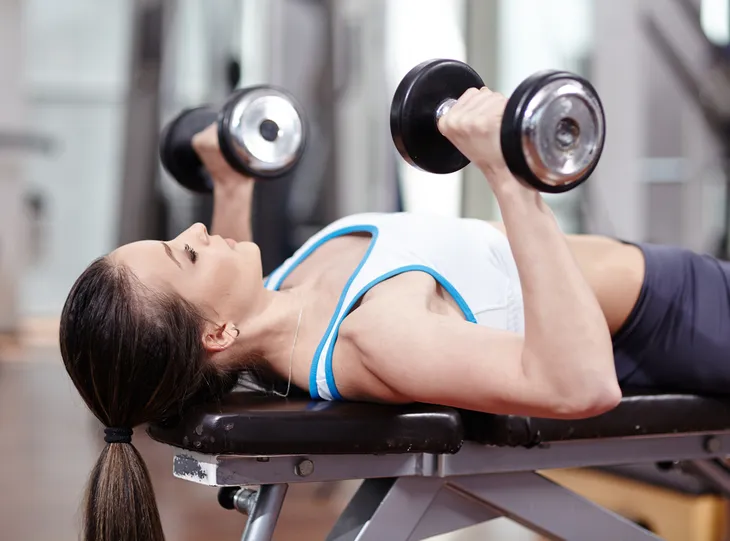When you enter the gym, which way should you head first? Toward the treadmills and spin studio to get your sweat on with a cardio session? Or toward the free weights and strength-training machines to do some resistance training?
The American College of Sports Medicine suggests doing both types of exercise to take advantage of their unique benefits for improving health and daily functioning and reducing chronic disease risk. But what is the optimal sequence to get the best results?
The answer to this question is … it depends. I’m an exercise physiologist. Recently in my lab we have been studying the effects of combinations of aerobic and resistance training on improving health-related fitness, particularly aerobic capacity and muscular strength.
Research suggests that when you’re designing your exercise program, there are a few factors to take into account, including your age, fitness level and exercise history and goals. You’ll also want to consider the volume of your exercise routine – that is, its duration and intensity – and how you’ll schedule your training during the day.
Benefits of exercise
First, just about any exercise at all is going to be better for you than doing nothing.
Aerobic exercise is rhythmic activity that gets your heart pumping. Examples are walking, running, swimming, cycling and using a cardio machine such as an elliptical trainer.
Aerobic exercise can improve cardiorespiratory function – over time, your heart and lungs get better at delivering oxygen to your muscles to make energy for continued muscle contractions. Aerobic exercise can also reduce several chronic disease risk factors, increase how much energy your body uses and how much fat it burns, and improve physical and cognitive function.
Resistance training involves strengthening your muscles by lifting, pushing or pulling against resistance. This type of exercise can be done using free-weight barbells, dumbbells, kettlebells, weight machines or even elastic bands.
Resistance exercise improves muscular strength, endurance and the power and the size of muscles – what exercise physiologists call muscle hypertrophy. Studies show resistance training has health-related benefits, as well, particularly for people who have or are at risk of developing Type 2 diabetes. It can improve blood pressure, blood levels of glucose and the ability of muscles to use glucose for energy, and it helps maintain lean body mass and bone health.
Training for health benefits
With a limited amount of time to devote to working out, many people include both cardio and weights in the same exercise session. This concurrent training comes with plenty of benefits for your health, including lowering your cardiovascular and metabolic risks.
In fact, doing both forms of exercise together is better, especially for people with chronic disease risk factors, than exercising for the same amount of time but sticking with just aerobic or resistance exercise.
Studies of concurrent training suggest a generalized training effect – similar improvements in aerobic capacity and muscular strength, regardless of the order of aerobic and resistance exercises in a session. These benefits hold for a wide variety of people, including those who are initially inactive, recreationally active, young people and older women and men.
Resistance exercise done before aerobic exercise results in a small increase in lower-body muscular strength without compromising all the other improvements in health-related physical fitness.
So if your exercise goals are along the lines of staying generally healthy and enjoying the mental benefits of moving your body, resistance training first might provide a little boost. Research suggests that overall, though, you don’t need to worry too much about which order to focus on – cardio versus weights.
Training with performance goals in mind
On the other hand, you may want be more thoughtful about the order of your workout if you’re a performance-oriented athlete who is training to get better at a particular sport or prepare for a competition.
Research suggests that for these exercisers, concurrent training may slightly inhibit improvement in aerobic capacity. More likely, it can hinder gains in muscular strength and power development, and to a lesser degree muscle growth. This phenomenon is called the “interference effect.” It shows up most in well-trained athletes undertaking high volumes of both aerobic and resistance exercise.
Researchers are still investigating what happens on a cellular level to cause the interference effect. Aerobic and resistance training unleash competing influences at the molecular level that affect genetic signaling and protein synthesis. At the start of an exercise program, the body’s adaptations are more generalized. But with more training, the muscle changes become more and more specific to the kind of work being done, and the likelihood of the interference effect kicking in increases.
Of course, many sports require combinations of aerobic and muscular capabilities. Some elite-level athletes need to improve both. So the question remains: What is the optimal order of the two modes of exercise to get the best performance effects?
Given research findings about concurrent training for high-level athletes, it makes sense to do resistance exercise first or to train first in the type of exercise that is most important to your performance goals. Additionally, if possible, elite athletes should give their bodies a break of at least three hours between resistance and aerobic training sessions.
Don’t sweat the order
In my lab, we’re studying what we call “microcycles” of aerobic and resistance exercise. Instead of needing to decide which to do first, you weave the two modalities together in much shorter bursts. For instance, one set of a resistance exercise is immediately followed by three minutes of walking or running; you repeat this cycle for as many times as necessary to include all of the resistance exercises in your routine.
Our preliminary findings suggest this method of concurrent training results in similar gains in aerobic fitness, muscular strength and lean muscle mass – while also feeling less challenging – when compared with the typical concurrent routine where all of the resistance exercise is followed by all of the aerobic exercise.
For most people, my current advice remains to choose the order of exercise based on your personal preferences and what will keep you coming back to the gym. High-level athletes can avoid any significant interference effect by doing their resistance routine before the aerobic routine or by separating their aerobic and resistance workouts within a particular day.
Randal Claytor, Associate Professor of Kinesiology, Nutrition and Health, Miami University
![]()
This article is republished from The Conversation under a Creative Commons license. Read the original article.







